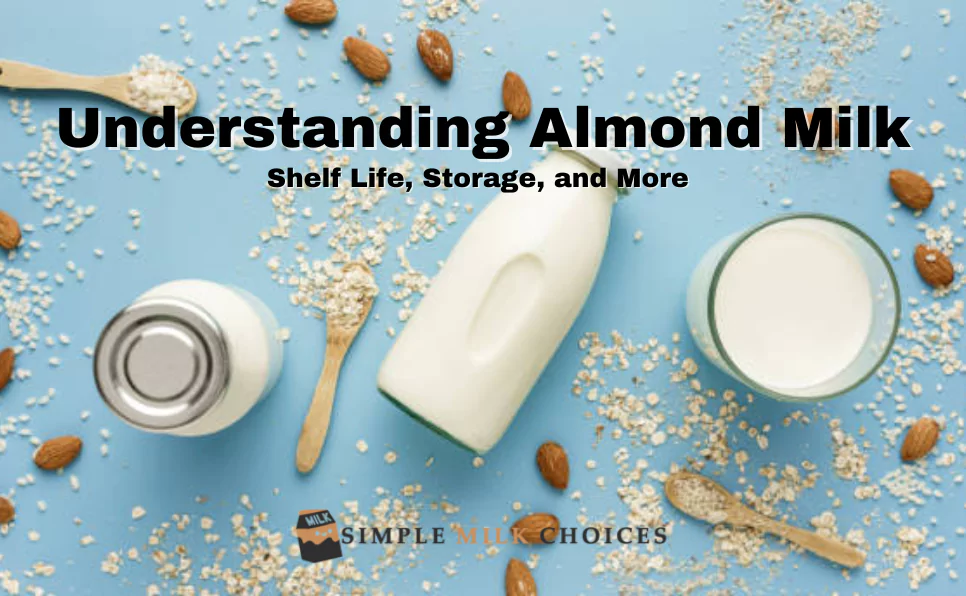Almond milk is a flexible and famous dairy-free option, in contrast to traditional cow’s milk. Its creamy surface and nutty flavor, and the fact that almond milk is hydrating, make it number one among those with lactose intolerance, veggie lovers, and people looking for a nutritious choice. However, with respect to almond milk, there are different concerns about its storage time and safety. In this detailed guide, we’ll look at frequently asked questions, as well as how long almond milk can last, how to store it, and what precautions to take.
The Fundamentals of Almond Milk
- Creation Cycle
- Healthy Benefits
Creation Cycle
Almond milk, an ideal choice for lattes as well, is created through a generally straightforward and eco-accommodating interaction. The creation cycle begins with almonds and water, bringing about a sans-dairy, nutty-enhanced milk elective.
- The cycle starts with the determination of great almonds. The almonds used to make almond milk should be fresh and free of signs of degradation.
- The almonds are soaked in water for a specific period of time. Soaking softens the almonds, making them simpler to mix and ensuring a smoother consistency in the end result.
- After making an impact, the almonds are completely mixed with water. This mixing system is urgent, as it helps to get the almonds with seasoning and supplements into the fluid.
- The almond-water blend is then stressed to eliminate solids. The solids consist of almond particles and any leftover almond skin. Stressing ensures that the milk is smooth and liberated from dirt.
- Depending upon the brand and customer inclinations, some almond milk makers might add regular flavors, sugars, or strongholds to improve the milk’s taste and wholesome profile.
- The completed almond milk is bundled in containers or jugs and prepared for dispersion.
The whole creation cycle is moderately direct, and it doesn’t include the utilization of creatures; settling on almond milk is a well-known decision for veggie lovers and those looking for dairy choices.
Healthy Benefits
Almond milk offers a few healthful advantages, including the fact that almond milk is more healthy compared to traditional cow’s milk.
- Almond milk is quite low in calories compared with cow’s milk. This makes it an appealing decision for people hoping to decrease their calorie consumption while still enjoying a creamy and fulfilling refreshment.
- Not the same as cow’s milk, almond milk is normally without cholesterol. This element is particularly interesting to those observing their cholesterol levels or following heart-sound eating routines.
- Almond milk and digestive health go hand in hand as it contains negligible soaked fat, which is frequently associated with coronary illness. Picking almond milk as a dairy supplement can add to an eating routine lower in saturated fat.
- Almonds are normally high in unsaturated fats, especially monounsaturated fats. These solid fats have been connected to different medical advantages, including further developed heart wellbeing.
- Calcium braces are used in many almond milk products sold in businesses, which is fundamental for maintaining serious areas of strength for the teeth. This settles on almond milk as a functional decision for those worried about their calcium consumption.
- A few brands also sustain almond milk with vitamin D, which assumes a pivotal role in calcium retention and, generally, bone wellbeing.
Period of Shelf Life of Almond Milk
Understanding the duration of the usability of almond milk is critical for ensuring its freshness and health. In this section, we will look into how long almond milk can remain under different circumstances, whether it’s unopened, opened, or left out at room temperature.
Unopened Almond Milk
Almond milk containers that aren’t opened have a long shelf life that allows customers to stock up on this dairy alternative without worrying about it going bad.
Capacity at Room Temperature:
Unopened almond milk containers can be stored safely at room temperature until the “best by” or “best before” date imprinted on the packaging. This date is a guideline from the manufacturer, telling you when the product should be of the best quality. It’s critical to take note of the fact that even after this date, the almond milk is generally safe to drink as long as it has been stored appropriately. This component adds to the comfort of almond milk as a storage space staple.
Opened Almond Milk
Whenever you’ve opened a container of almond milk, the time duration of usability elements changes, and it’s fundamental to comply with explicit rules to keep up with its freshness.
Refrigeration is Vital:
After opening the carton, almond milk should be refrigerated right away. Refrigeration slows down the growth of any potential microorganisms, extending the shelf life of the milk and ensuring its safety for consumption.
7–10 Days:
It is prescribed to consume opened almond milk within 7–10 days. This period gives a sensible window of time to enjoy the freshness and nature of the milk. After this time period, there’s an expanded risk of breakdown and changes in flavor and surface.
The Two-Hour Rule
One normal concern among buyers is whether almond milk can be safely left out at room temperature. The “two-hour rule” fills in as a viable rule to address this concern.
Two-Hour Time Period:
According to this rule, you can keep almond milk at room temperature for up to two hours after opening it. Within this window, the almond milk stays protected for drinking. However, it’s critical to think about the summarizing temperature and conditions, as leaving almond milk out in a warm or bright climate can speed up the growth of microorganisms, decreasing its health.

Indications of Spoilage
To ensure your almond milk is protected and pleasant, it’s crucial to have the option to recognize the warning signs of spoilage. Almond milk that has turned sour might show the following indicators:
Sour Odor
Spoiled almond milk frequently has a sharp or upsetting odor. If you notice a weird or unpleasant smell, it’s an obvious indicator that the milk is weaker and should be wasted.
Changes in Surface
New almond milk commonly has a smooth and steady surface. If you notice any changes, for example, curdling or the advancement of bumps, it’s a sign that the milk has been ruined.
Coagulated Appearance
Almond milk that has turned sour might seem curdled or have an unbalanced consistency. This visual change is a reasonable sign that the milk is currently not appropriate for utilization.
By understanding these rules, you can confidently manage the shelf life of your almond milk, whether you have it unopened, opened, or temporarily left out at room temperature.

Storage and Handling Tips
Refrigeration
Refrigeration is a basic part of ensuring almond milk stays fresher and is safe to drink. Putting almond milk in the refrigerator expands its timeframe of reasonable usability as well as keeping up with its quality. Here are a few central issues to consider while refrigerating almond milk:
Temperature Setting:
Set your cooler to the suggested temperature range of 34–38°F (1-3°C). This ensures that almond milk, along with other transitory things, stays at an ideal temperature for protection.
Organization:
Organize your refrigerator effectively. Store almond milk containers in the entryway, which is exposed to temperature changes each time the refrigerator is opened. All things considered, put them on a rack nearer to the back and center of the refrigerator, where the temperature is steadier.
Fixing Holders:
If you have opened almond milk but haven’t utilized the whole container, ensure that it is appropriately fixed. Hermetically sealed sections, like a resealable jug or a plastic cap, can assist with preventing openness to air and expected spoilage.
Shaking the Holder
After some time, almond milk can go through normal separation, with the denser particles settling at the base. To ensure a reliable surface and flavor, shaking the compartment before each use is essential. This is the way to actually shake almond milk:
Secure the Cap:
Prior to shaking, ensure the holder is properly fixed. Ensure the cap or top is firmly shut to prevent any leakage during shaking.
Shake Enthusiastically:
Hold the container with the cap looking lower and give it an overpowering shake for around 10–15 seconds. This activity reallocates the settled particles and ensures uniform consistency.
Check for Consistency:
After shaking, outwardly review the almond milk. It should appear rich and thoroughly blended, indicating that it’s ready for use in recipes, beverages, or as a milk substitute.
Utilizing a Devoted Container
For people who often drink almond milk, utilizing a devoted almond milk distributor or container can be a reasonable decision. Such holders are intended to limit openness to air and keep up with the freshness of almond milk. This is the reason and the way to utilize a committed holder:
Diminished Air Openness:
Devoted almond milk compartments frequently have unbreakable seals or terminations that decrease air openness, preventing untimely deterioration and keeping up with quality.
Convenience:
These holders are not difficult to use, with elements like spouts or pour covers simplifying them to quantify and apportion almond milk without continued opening of the container.
Refrigeration:
After moving almond milk to a dedicated container, make sure to store it in the refrigerator. The standards of refrigeration and temperature control actually apply to keep up with freshness.
Usage Rules
To ensure the best taste and health of almond milk, it’s crucial to observe explicit rules on when to consume it after opening. These rules change marginally with unopened almond milk. Here are the principles to remember:
7–10 Days:
Once opened, almond milk ought to be consumed within 7–10 days. This window guarantees that you partake in the freshest and most secure almond milk. After this period, the quality might start to break down.
Capacity Area:
When not in use, store the open almond milk container in the refrigerator, following the refrigeration guidelines mentioned earlier in this section.
Visual and Tangible Checks:
Before using almond milk that has been open for a while, perform visual and sensory checks. Make sure it hasn’t developed any signs of deterioration, such as a sour odor, changes in texture, or a curdled appearance.
By observing these use guidelines and dealing with tips, you can boost the timeframe of realistic usability of almond milk and keep up with its quality all through its utilization.
FAQ's: Common Questions about Almond Milk
To address the normal inquiries about almond milk and its reasonable shelf life, we should look into a few regularly sought clarifications on some pressing issues:
Does almond milk turn sour if it is left out?
Without a doubt, almond milk can turn sour if left out at room temperature for a long period of time. After two hours, the spoilage ought to be refrigerated.
How long can you leave almond milk out?
You can leave almond milk at room temperature for as long as two hours after opening. After that, refrigerate it or dispose of it to maintain its freshness.
How long can almond milk sit out in a baby bottle?
You shouldn’t ignore a child’s bottle of almond milk for longer than two hours. Focusing on your child’s safety and security is of the utmost significance.
How long can almond milk sit out unopened?
Unopened almond milk can sit out at room temperature until the “best by” date, which is ordinarily a while from the buy date. Continuously counsel the bundling for the producer’s particular date.
How long might almond milk pass on after opening?
To ensure both freshness and safety, consumers should consume almond milk within 7-10 days after opening it.





